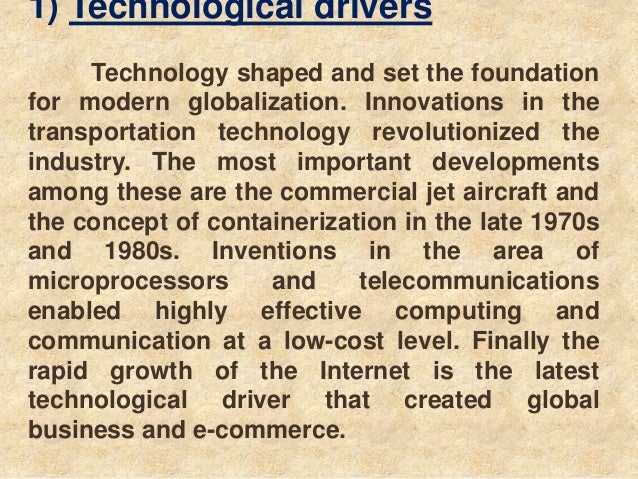Five Major Drivers Of Globalization
Answer to There are five major kinds of globalization drivers, all based on changes that are leading international firms to the. Mar 10, 2014 - Drivers of Globalization The media and almost every book on. Different drivers of globalization and they can basically be separated into five. 23 Its innovation drives globalization because of quick and efficient transmission of. United States, for example, attacked Iraq even though three of the five.

Drivers & hurdles of globalization. 1. V.B.Shah Institute of Management Subject: Business Environment Topic: Drivers & Hurdles of Globalization. Roll no. Download buku metode penelitian sugiyono 2013. Name 226 Nasit Janak 236 Patel Vidur 237 Patel Vikas 238 Patel Vinay 239 Pathak Denish 252 Savani Jay TYBBA (Div-2) Group Members. Globalization The term Globalization refers to processes of international integration arising from the interchange of world views, products, ideas, and other aspects of culture.
Advances in transportation and Telecommunications, infrastructure, including the rise of the telegraph and its posterity the Internet, are major factors in globalization, generating further interdependence of economic and cultural activities. Drivers of Globalization The media and almost every book on globalization and international business speak about different drivers of globalization and they can basically be separated into five different groups:. 1) Technological drivers Technology shaped and set the foundation for modern globalization. Innovations in the transportation technology revolutionized the industry. The most important developments among these are the commercial jet aircraft and the concept of containerization in the late 1970s and 1980s.
Inventions in the area of microprocessors and telecommunications enabled highly effective computing and communication at a low-cost level. Finally the rapid growth of the Internet is the latest technological driver that created global business and e-commerce. 2) Political drivers Liberalized trading rules and deregulated markets lead to lowered tariffs and allowed foreign direct investments in almost all over the world. The institution of GATT (General Agreement on Tariffs and Trade) 1947 and the WTO (World Trade Organization) 1995 as well as the ongoing opening and privatization in Eastern Europe are only some examples of latest developments. 3) Market driversAs domestic markets become more and more saturated, the opportunities for growth are limited and global expanding is a way most organizations choose to overcome this situation.
Common customer needs and the opportunity to use global marketing channels and transfer marketing to some extent are also incentives to choose internationalization. 4) Cost drivers Sourcing efficiency and costs vary from country to country and global firms can take advantage of this fact. Other cost drivers to globalization are the opportunity to build global scale economies and the high product development costs nowadays. 5) Competitive drivers with the global market, global inter- firm competition increases and organizations are forced to “play” international. Strong interdependences among countries and high two-way trades and FDI actions also support this driver. Hurdles of Globalization 1)Technological Barriers Standards-related trade measures, known in WTO parlance as technical barriers to trade play a critical role in shaping global trade. Governments, market participants, and other entities can use standards-related measures as an effective and efficient means of achieving legitimate commercial.
Market Drivers Of Globalization
regulations and testing, certification, and other procedures are involved in determining whether or not products conform to standards and technical regulations. Significant foreign trade barriers in the form of product standards, technical regulations and testing, certification, and other procedures are involved in determining whether or not products conform to standards and technical regulations. 2) Cultural BarriersIt is typically more difficult to do business in a foreign country than in one’s home country due to cultural barriers. With the process of globalization and increasing global trade, it is unavoidable that different cultures will meet, conflict, and blend together.
People from different cultures find it is hard to communicate not only due to language barriers but also cultural differences. It is typically more difficult to do business in a foreign country than in one’s home country, especially in the early stages when a firm is considering either physical investment in or product expansion to another country. Expansion planning requires an in- depth knowledge of existing market channels and suppliers, of consumer preferences and current purchase behavior, and of domestic and foreign rules and regulations. 3) Ethical Barriers Despite international trading laws and declarations, countries continue to face challenges around ethical trading and business practices. Although some argue that the increasing integration of financial markets between countries leads to more consistent and seamless trading practices, others point out that capital flows tend to favor the capital owners more than any other group.
Key Drivers Of Globalization
With increased international trade and global capital flows, critics argue that income disparities between the rich and poor are exacerbated, and industrialized nations grow in power at the expense of under-capitalized countries. Anti-globalization groups continue to protest what they view as the unethical trading practices of multinational businesses and capitalist nations, often targeting groups such as the WTO and IMF. 4) Economics Barriers Trade barriers are government-induced restrictions on international trade, which generally decrease overall economic efficiency. Trade barriers cause a limited choice of products and, therefore, would force customers to pay higher prices and accept inferior quality. Trade barriers generally favor rich countries because these countries tend to set international trade policies and standards. Economists generally agree that trade barriers are detrimental and decrease overall economic efficiency, which can be explained by the theory of comparative advantage.